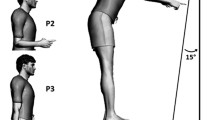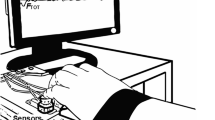Abstract
This study joined two approaches to motor control. The first approach comes from cognitive psychology and is based on the idea that goal postures and movements are chosen to satisfy task-specific constraints. The second approach comes from the principle of motor abundance and is based on the idea that control of apparently redundant systems is associated with the creation of multi-element synergies stabilizing important performance variables. The first approach has been tested by relying on psychophysical ratings of comfort. The second approach has been tested by estimating variance along different directions in the space of elemental variables such as joint postures. The two approaches were joined here. Standing subjects performed series of movements in which they brought a hand-held pointer to each of four targets oriented within a frontal plane, close to or far from the body. The subjects were asked to rate the comfort of the final postures, and the variance of their joint configurations during the steady state following pointing was quantified with respect to pointer endpoint position and pointer orientation. The subjects showed consistent patterns of comfort ratings among the targets, and all movements were characterized by multi-joint synergies stabilizing both pointer endpoint position and orientation. Contrary to what was expected, less comfortable postures had higher joint configuration variance than did more comfortable postures without major changes in the synergy indices. Multi-joint synergies stabilized the pointer position and orientation similarly across a range of comfortable/uncomfortable postures. The results are interpreted in terms conducive to the two theoretical frameworks underlying this work, one focusing on comfort ratings reflecting mean postures adopted for different targets and the other focusing on indices of joint configuration variance.






Similar content being viewed by others
References
Bernstein NA (1967) The co-ordination and regulation of movements. Pergamon Press, Oxford, New York
Enoka RM, Duchateau J (2008) Muscle fatigue: what, why and how it influences muscle function. J Physiol 586:11–23
Enoka RM, Baudry S, Rudroff T, Farina D, Klass M, Duchateau J (2011) Unraveling the neurophysiology of muscle fatigue. J Electromyogr Kinesiol 21:208–219
Gehrmann S, Tang J, Kaufmann RA, Goitz RJ, Windolf J, Li ZM (2008) Variability of precision pinch movements caused by carpal tunnel syndrome. J Hand Surg Am 33:1069–1075
Gelfand IM, Latash ML (1998) On the problem of adequate language in motor control. Mot Control 2:306–313
Gera G, Freitas SMSF, Latash ML, Monahan K, Schöner G, Scholz JP (2010) Motor abundance contributes to resolving multiple kinematic task constraints. Mot Control 14:83–115
Hogan N (1984) An organizing principle for a class of voluntary movements. J Neurosci 4:2745–2754
Jaspen N (1946) Serial correlation. Psychometrika 11:23–30
Jones KE, Hamilton AF, Wolpert DM (2002) Sources of signal-dependent noise during isometric force production. J Neurophysiol 88:1533–1544
Latash ML (2012a) The bliss (not the problem) of motor abundance (not redundancy). Exp Brain Res 217:1–5
Latash ML (2012b) Movements that are both variable and optimal. J Hum Kinet 34:5–13
Latash ML, Kang N, Patterson D (2002) Finger coordination in persons with Down syndrome: atypical patterns of coordination and the effects of practice. Exp Brain Res 146:345–355
Latash ML, Scholz JP, Schoner G (2007) Toward a new theory of motor synergies. Mot Control 11:276–308
Martin V, Scholz JP, Schoner G (2009) Redundancy, self-motion, and motor control. Neural Comput 21:1371–1414
Mattos DJ, Latash ML, Park E, Kuhl J, Scholz JP (2011) Unpredictable elbow joint perturbation during reaching results in multijoint motor equivalence. J Neurophysiol 106:1424–1436
Murray RM, Li Z, Sastry SS (1994) A mathematical introduction to robotic manipulation. CRC Press, Boca Raton
Nelson WL (1983) Physical principles for economies of skilled movements. Biol Cybern 46:135–147
Newell KM (1986) Constraints on the development of coordination. In: Wade MG, Whiting HTA (eds) Motor development in children: aspects of coordination and control. Martinus Nijhoff, Dordrecht, pp 341–360
Park J, Zatsiorsky VM, Latash ML (2010) Optimality vs. variability: an example of multi-finger redundant tasks. Exp Brain Res 207:119–132
Park J, Sun Y, Zatsiorsky VM, Latash ML (2011) Age-related changes in optimality and motor variability: an example of multifinger redundant tasks. Exp Brain Res 212:1–18
Park J, Singh T, Zatsiorsky VM, Latash ML (2012) Optimality versus variability: effect of fatigue in multi-finger redundant tasks. Exp Brain Res 216:591–607
Rosenbaum DA, Marchak F, Barnes HJ, Vaughan J, Slotta J, Jorgensen M (1990) Constraints for action selection: overhand versus underhand grips. In: Jeannerod M (ed) Attention and performance XIII: motor representation and control. Lawrence Erlbaum associates, Hillsdale, NJ, pp 321–342
Rosenbaum DA, Meulenbroek RJ, Vaughan J, Jansen C (2001) Posture-based motion planning: applications to grasping. Psychol Rev 108:709–734
Rosenbaum DA, Vaughan J, Meulenbroek RGJ, Jax S, Cohen R (2009) Smart moves: the psychology of everyday perceptual-motor acts. In: Morsella E, Bargh JA, Gollwitzer PM (eds) Oxford handbook of human action. Oxford University Press, New York, pp 121–135
Rosenbaum DA, Chapman KM, Weigelt M, Weiss DJ, van der Wel R (2012) Cognition, action, and object manipulation. Psychol Bull 138:924–946
Sagvolden T, Johansen EB, Aase H, Russell VA (2005) A dynamic developmental theory of attention-deficit/hyperactivity disorder (ADHD) predominantly hyperactive/impulsive and combined subtypes. Behav Brain Sci 28:397–419
Scholz JP, Schoner G (1999) The uncontrolled manifold concept: identifying control variables for a functional task. Exp Brain Res 126:289–306
Scholz JP, Schoner G, Latash ML (2000) Identifying the control structure of multijoint coordination during pistol shooting. Exp Brain Res 135:382–404
Seif-Naraghi AH, Winters JM (1990) Optimized strategies for scaling goal-directed dynamic limb movements. In: Winters JM, Woo SL-Y (eds) Multiple muscle systems. Biomechanics and movement organization. Springer, New York, pp 312–334
Simon H (1955) A behavioral model of rational choice. Q J Econ 69:99–118
Soderkvist I, Wedin PA (1993) Determining the movements of the skeleton using well-configured markers. J Biomech 26:1473–1477
Todorov E (2004) Optimality principles in sensorimotor control. Nat Neurosci 7:907–915
Tseng YW, Scholz JP (2005) The effect of workspace on the use of motor abundance. Mot Control 9:75–100
Tseng YW, Scholz JP, Schöner G, Hotchkiss L (2003) Effect of accuracy constraint on joint coordination during pointing movements. Exp Brain Res 149:276–288
Zhang W, Scholz JP, Zatsiorsky VM, Latash ML (2008) What do synergies do? Effects of secondary constraints on multidigit synergies in accurate force-production tasks. J Neurophysiol 99:500–513
Acknowledgments
The study was in part supported by NIH grants AG-018751, NS-035032, and AR-048563.
Author information
Authors and Affiliations
Corresponding author
Appendix 1
Appendix 1
Uncontrolled manifold analysis (more details in Scholz and Schoner (1999) and Scholz et al. 2000)
The reference joint configuration vector (\( \overline{{\underline{\theta } }} \)) was calculated at each time step of a pointing posture by averaging joint angles across trials. We used forward kinematic model parameters (Scholz et al. 2000) to create Jacobian matrix (\( \underline{\underline{J}} (\underline{{\overline{\theta } }} ) \)). This matrix determines how infinitesimal deviations of each joint from \( \overline{{\underline{\theta } }} \) affect performance variable (pointer position or pointer orientation). Subsequently, the null-space of \( \underline{\underline{J}} (\underline{{\overline{\theta } }} ) \) was numerically obtained from the singular value decomposition, solving
where each column of \( \underline{\underline{E}} \) is a basis vector. The null-space of \( \underline{\underline{J}} (\underline{\theta } ) \) represents configurations of joint angles that keep the performance variable unchanged; it was used as a linear approximation of the UCM. The deviation of joint angles from the reference configuration (\( \underline{\theta } - \underline{{\overline{\theta } }} \)) were projected onto the null-space at each time step, using:
where \( \underline{\underline{P}} \) is the projection matrix
The projection of the deviations of the joint configuration from its average value on the orthogonal subspace (\( \underline{\theta }_{\text{ORT}} \)) was computed as:
The following formulas for calculating per dimension variance along \( \underline{\theta }_{\text{UCM}} \) and \( \underline{\theta }_{\text{ORT}} \) projections were used
The total variance \( V_{\text{TOT}} \) was computed as
Rights and permissions
About this article
Cite this article
Solnik, S., Pazin, N., Coelho, C.J. et al. End-state comfort and joint configuration variance during reaching. Exp Brain Res 225, 431–442 (2013). https://doi.org/10.1007/s00221-012-3383-2
Received:
Accepted:
Published:
Issue Date:
DOI: https://doi.org/10.1007/s00221-012-3383-2




